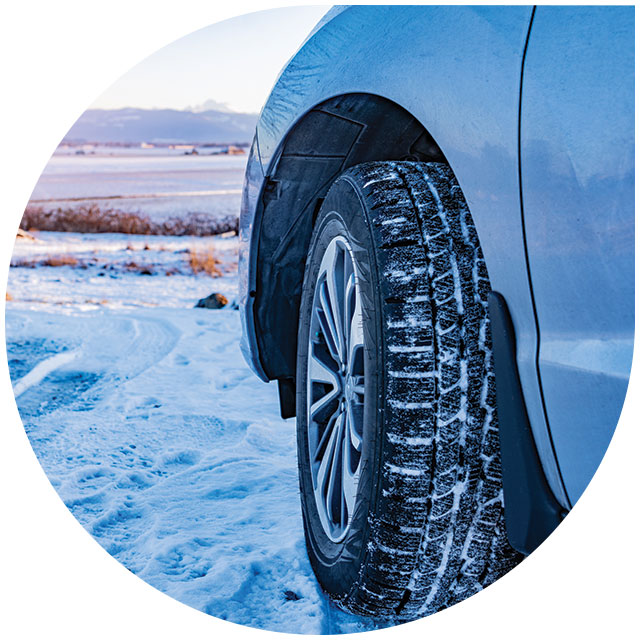Winter tires
- Maximum traction on slippery surfaces.
- Shortened braking distance in winter conditions.
- Better vehicle control on snow and ice.
Winter tires perform best at temperatures below +7°C. They feature a soft rubber compound and a deep tread with sipes that improve traction on snow, ice, and slush. Driving on winter tires in Poland is not legally required, but it is strongly recommended for safety reasons.
Interesting fact :
Some winter tires have a special symbol “3PMSF” (three peaks with a snowflake), which confirms their effectiveness in difficult winter conditions.

Which winter tires should you choose? We'll advise you!
Wondering which winter tires are best for your car? Choosing the right tires is crucial for driving safety and comfort in challenging winter conditions. Winter tires should perform effectively on snow, ice, and at low temperatures.
When choosing winter tires, consider your driving style, vehicle type, and budget. Economy, mid-range, and premium tires are available , making it easy to find the right model for your needs. Properly selected winter tires improve traction, shorten braking distances, and provide better vehicle control.
Choose proven winter tires and enjoy safe driving even in the most difficult conditions!
Why is it worth choosing winter tires?
Winter tires are designed from the ground up for safe driving in challenging winter conditions. Temperature is a key factor in their effectiveness. Low temperatures affect the elasticity of the rubber, which directly translates into better traction and vehicle stability on the road.
Winter tires use a special rubber compound that remains soft even in extreme frost. Additionally, the tires feature a specially designed tread, whose deep grooves and sipes effectively “bite” into the snow and provide good traction even on icy surfaces. This makes winter driving safer, more comfortable, and more predictable.
The most popular winter tire diameters
⌀ 13″
⌀ 14″
⌀ 15″
⌀ 16″
⌀ 17″
⌀ 18″
⌀ 19″
⌀ 20″
⌀ 21″
⌀ 22″
Cheap winter tires – safety at a good price
Wondering which affordable winter tires perform well on snow and ice? Winter road conditions are among the most challenging, so even if you’re on a tight budget, it’s worth investing in durable and safe tires.
Don’t risk driving on used or retreaded tires of unknown origin. In our store, you’ll find affordable winter tires from reputable manufacturers that will provide you with adequate traction, shorter braking distances, and driving stability on snowy and icy surfaces.
Choose proven winter tires at a low price and enjoy safe driving all winter long!
When to change to winter tires?
For many drivers, seasonal tire replacement is not only an additional expense but also a dilemma about when it’s best to switch to winter tires. Knowing the basics and observing weather conditions can help avoid unpleasant surprises on the road and ensure your safety and that of your passengers.
Experts recommend changing to winter tires when temperatures regularly drop below 7°C. It’s best to do this well in advance, before the first snowfall and icy roads. This will help you avoid long lines at tire shops, which are especially crowded during the first frosts.
Remember – the right time to change to winter tires is a guarantee of safe and comfortable driving throughout the winter.
Winter tires from A to Z
Driving on summer tires in winter – why is it a bad idea?
Matching tires to the season and road conditions is crucial for safety. Choosing the right tires not only impacts driving comfort but also, and more importantly, traction, stability, and braking distance.
Driving on summer tires in winter is a serious hazard on the road. As temperatures drop, the rubber compound in summer tires hardens, significantly reducing traction. Even a slight change in the weather can cause your car to struggle to move off, significantly increasing braking distances.
For your safety and the safety of others on the road, always change to winter tires before the frost arrives. This will ensure better vehicle control and a smoother ride in challenging winter conditions.
Winter tire markings – how to recognize them?
Winter tires must meet specific requirements to ensure safety and driving comfort in challenging conditions. Crucial factors include a rubber compound that remains flexible even at very low temperatures, and a suitable tread pattern that guarantees good traction and short braking distances on snow, ice, and slush.
Fortunately, recognizing winter tires is very easy. Just check the markings on the tire sidewall. The most important symbol is 3PMSF (Three Peak Mountain Snowflake – A snowflake icon with three mountain peaks in the background confirms that the tire has passed winter testing. You’ll also see the M+S ( Mud and Snow ) marking, indicating improved traction in mud and snow, although only the 3PMSF symbol guarantees full winter performance.
Choose tires with appropriate markings to enjoy confident and safe driving throughout the winter season.
Winter tire tread depth – why does it matter?
New winter tires have a tread depth of approximately 8-10 mm, providing excellent traction and safety on snow, ice, and wet surfaces. Over time, the tread wears down and its height gradually decreases, directly impacting the tire’s performance during winter driving.
In winter, roads are often covered with snow, slush, or water, so proper winter tire tread depth is crucial for maintaining traction and shortening braking distances. The minimum recommended tread depth is 4 mm – below this value, tire performance significantly decreases, and the risk of skidding increases.
Check your tread regularly to ensure your winter tires provide maximum safety in all conditions.